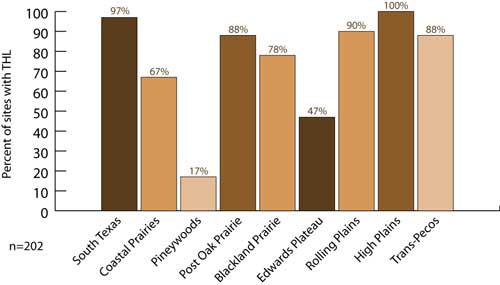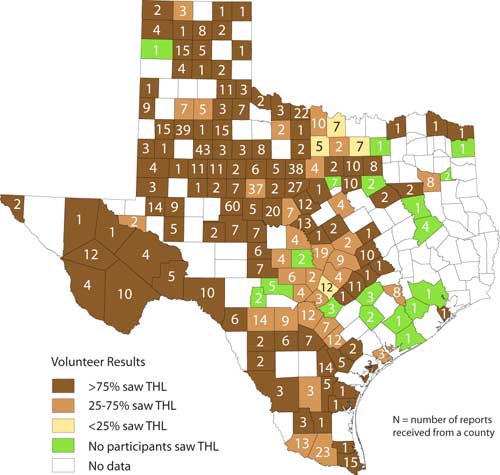Texas Horned Lizard Watch 10-Year Summary Report
Results – Prevalence
A map of THL prevalence based on 10 years of data from Texas Horned Lizard Watch (fig. 3) reveals a complex pattern of distribution.
THL are apparently rare in the Coastal Prairie region of Texas, although they persist in sandy soils of some coastal counties where volunteers have sighted them on barrier islands. Moving inland, THL are still regularly reported from counties within the Post Oak Savannah ecoregion. These counties are characterized by sandy soils and less intensive agriculture. Few reports have been received from the Pineywoods (fig. 4), perhaps due to historic as well as current scarcity of THL. THL appear to be rare in a belt that follows the counties of the IH-35 corridor north from San Antonio. Urbanization, intensive agriculture in Blackland Prairie soils, and prevalence of red imported fire ants (Solenopsis invicta) may be associated with declining trends in this region. Two puzzling exceptions are Tarrant and Dallas counties, where 15 sightings have been made in the past decade. Results are mixed in the Rolling Plains and Edwards Plateau ecoregions, with some counties reporting THL present and other volunteers, especially those in the more eastern edge, reporting that THL have not been seen in many years. Urbanization and fire ants may be exerting local effects on populations. Horned lizards are prevalent in much of the South Texas Brush Country, although some declines are reported along the northern edges of this ecoregion, roughly following US 90 and IH-37. Declines have also been reported for many years in the Lower Rio Grande Valley, presumably associated with urbanization and intensive agriculture, although THL still can be commonly encountered in this region. Finally, West Texas remains the stronghold for the species. THL are still widely reported from the High Plains and the Trans-Pecos, although the species is reported to be less abundant in many urban areas.

Figure 4: Percent of sites reporting Texas Horned Lizards, by ecoregion, 1997-2006
 (
(